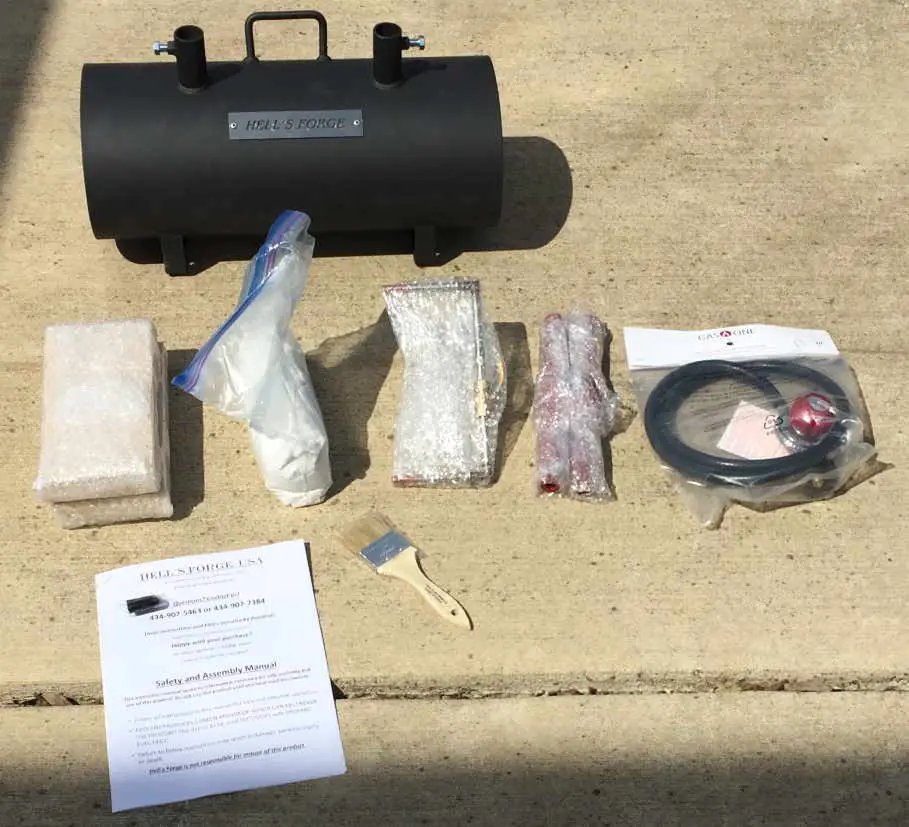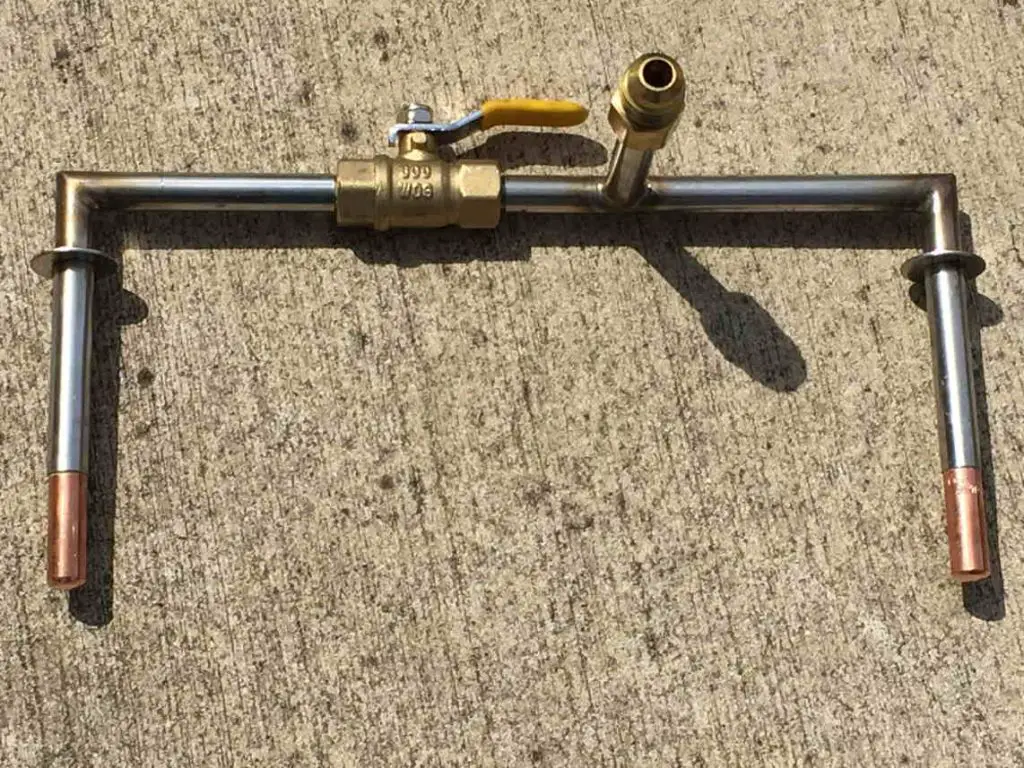The hell’s forge double burner has a lot of the same benefits as other propane forges. It’s clean, there is no smoke, you can control your temperature more easily than you can other solid fuel forges and they provide a consistent heat. They are easy to set up, and easy to put away once you are done with them. Most blacksmiths and knife makers have a propane forge – even if they prefer to use a solid fuel forge – as propane forges are incredibly efficient to start up and are quicker to use in cases of a time crunch.
For the price range this forge is well built, and in my opinion will make a great starter forge for someone who doesn’t already have a lot of metal working tools. If you can build your own forge that’s great, but that’s not an option for a lot of people and I think this forge is a good stepping stone for people new to the craft.

There are some downsides however. The hells forge double burner propane forge has a lot of the same problems as other propane forges.
For starters, it’s VERY noisy.
You must also be very careful not to get flux on the ceramic blanket or it will melt it like water on a sugar cube. This is true for all forges made of ceramic wool and is not unique to this model.
There are other issues as well. All propane forges release carbon monoxide, this forge is no different. The manufacturers themselves recommend that you only use this product outside.
It also has one problem that is unique to this product: the burners are positioned directly on top of the forge, and they shoot straight down into the bottom of the forge. Many smiths, especially knife makers, like the burners off at an angle as this creates more of a swirl pattern with the flames as they bounce off the angled side wall. The thinking goes that swirly flames create a more even heat than flames that shoot straight down.
This isn’t really a deal breaker in my opinion, and lots of people – myself included – have successfully made knives using this forge.
The upshot of this design is that you can easily place a hard firebrick at the bottom of the forge directly in front of the flames initial path, this prolongs the life of your coated wool.
My experience with assembly & additional info

The manufacturers apply a rigidizer before shipment. The wool on my forge was slightly crispy and burnt at the point where the red burner pipes entered the shell. I suspect this was from when they cured the rigidizer at the plant.
The forge comes with a container of HELLCOAT 3000 Refractory Coating to be applied by you. This coating helps contain loose fibers from the blanket and improves the longevity of your forge. These ceramic blankets are not good for your lungs, especially when they start to burn and get crispy, so I applied my coating good and thick.
There are serious occupational risks associated with blacksmithing, I suggest you take potential dangers seriously. To see what I mean, look at this sad thread over on iforgeiron about a 28 year old who ended up needing a lung transplant : https://www.iforgeiron.com/topic/53239-ceramic-wool-insulation-safety-alert/
But don’t be turned away, just be cautious. There are smiths that have been using propane forges for DECADES without issues. Just remember, the paranoid survive!
I wore a respirator with p100 filters while setting up my forge – but this does not constitute as a safety recommendation. I don’t know enough about these ceramic blankets to know whether that’s sufficient or not, but I do know that when I began to apply my hellcoat 3000 coating A LOT of small fibers were kicked up and were visibly floating in the air. I’m glad I did this upwind outside, and I”m glad I had my respirator on tight.
I also recommend you wear disposable gloves that go at least half way up your forearm while applying the hellcoat mix. Even if you are careful you will get some coating on your hands and arms. It’s not a bad idea to wear clothing you don’t care about as some coating may get on your clothes. I applied the coating to the middle of the forge first, and then worked my way outwards to minimize the gunk that got on my arms.
I also dusted/hit my clothes with a broom when I was done applying the coat, but I”m a paranoid germaphobe and didn’t want to track refractory dust into the house.
The refractory coating just looks like grey clay.
The instructions say to mix your coating until it is the consistency of a thick smoothie. I did this and it applied fairly easy, but I had a hard time filling gaps that would form every time the ceramic blanket had a change in the shape of its folds.These folds squished around every time I applied more of the mix, so I”m glad that they give you A LOT of hellcat 3000. I think if I had made the last ⅕ of my coating a little runnier, I may have been able to fill in the last few gaps better, but it’s hard to say for certain now that it’s all said and done.
Overall the assembly experience was pretty easy. Putting the different components together was easy. I tested my assembly for leaks with soapy water and found none. The rubber caps they give you for this test are TIGHT by necessity.
My experience curing the Hellcoat 3000
Curing was easy.
I had issues with a sputtering flame the first time I tried to light the forge – however it was my fault for not reading the instructions thoroughly. The instructions clearly state you need to close the choke to unused burners when lighting…I just got excited and forgot!
Would I Recommend This Forge To A Friend?
Yes. This forge does everything it advertises and is a great forge for people who don’t want to make their own forge.
If someone already has a lot of metal working tools and wants to build their own forge, then they should do that. If someone has lots of strong opinions about what the perfect forge looks like, then they should build their own forge.
For everyone else, I recommend you pick one up here. Too many new smiths spend months dragging their feet and getting stuck in paralysis by analysis. Buy this forge, read the instructions front to back thoroughly, and begin forging.
I have had a lot of fun with this forge, and suspect you will too!
Heat Times
Detailed table coming soon – it heats up steel from a cold start MUCH faster than my solid fuel forge.
How Long does a 20lb tank of propane last with the Hells Forge Propane Forge?
4-6 hours at 20 psi max capacity with both burners, I usually run only one burner at about 50%-75% and this lasts quite a bit longer.
Can the hells forge double burner propane forge forge weld?
Yes. I will post pictures soon.